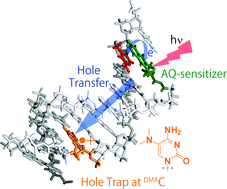Synthesis and photooxidation of oligodeoxynucleotides containing 5-dimethylaminocytosine as an efficient hole-trapping site in the positive-charge transfer through DNA duplexes†
Abstract
We have designed and synthesized

* Corresponding authors
a
Advanced Biomedical Engineering Research Unit, Kyoto University, Katsura, Nishikyo-ku, Kyoto, Japan
E-mail:
yamada.hisatsugu.3r@kyoto-u.ac.jp
Fax: +81-75-383-2805
Tel: +81-75-383-7554
b
Department of Energy and Hydrocarbon Chemistry, Graduate School of Engineering, Kyoto University, Katsura, Kyoto, Japan
E-mail:
nishimot@scl.kyoto-u.ac.jp
Fax: +81-75-383-2501
Tel: +81-75-383-2500
We have designed and synthesized

 Please wait while we load your content...
Something went wrong. Try again?
Please wait while we load your content...
Something went wrong. Try again?
H. Yamada, M. Kurata, K. Tanabe, T. Ito and S. Nishimoto, Org. Biomol. Chem., 2012, 10, 2035 DOI: 10.1039/C2OB06642D
To request permission to reproduce material from this article, please go to the Copyright Clearance Center request page.
If you are an author contributing to an RSC publication, you do not need to request permission provided correct acknowledgement is given.
If you are the author of this article, you do not need to request permission to reproduce figures and diagrams provided correct acknowledgement is given. If you want to reproduce the whole article in a third-party publication (excluding your thesis/dissertation for which permission is not required) please go to the Copyright Clearance Center request page.
Read more about how to correctly acknowledge RSC content.
 Fetching data from CrossRef.
Fetching data from CrossRef.
This may take some time to load.
Loading related content
